 If you’ve visited our equipment forum at any point in the past, you’ve most likely seen a thread in which someone asks for putter recommendations. Shortly thereafter, you’re sure to see someone mention how a putter is a “personal choice” or “personal experience.” How much more “personal” would that putter be if you won the Open Championship or the U.S. Open with it?
If you’ve visited our equipment forum at any point in the past, you’ve most likely seen a thread in which someone asks for putter recommendations. Shortly thereafter, you’re sure to see someone mention how a putter is a “personal choice” or “personal experience.” How much more “personal” would that putter be if you won the Open Championship or the U.S. Open with it?
Following that line of thinking, it might be safe to say that the recently announced Nike Method is so personal to Stewart Cink and Lucas Glover, their significant others might be a little jealous at this point. Nike Golf‘s putters have been somewhat of an enigma in the past few years. While it’s true that the IC and Unitized series may have had a few wild looking variations, they were generally met with good reviews, yet somehow, they never really had same degree of retail success that Nike’s woods, irons, and balls did. Nike again enters the high-end putter market with the new Method line, and this time, the performance is already validated by a couple of high-profile major championship wins. Follow as we take a quick look at the new Method putter from Nike Golf!
The Method putter is another in the long line of innovative clubs that was created in Nike Golf’s R&D madhouse affectionately known as “The Oven.” Say what you will about Nike Golf, but I think you’d be hard pressed to find anyone that would turn down an invitation to the Fort Worth based facility. The crew at The Oven set out to make a familiar looking putter that also contained the technology to make the ball consistently roll truer to your stroke.
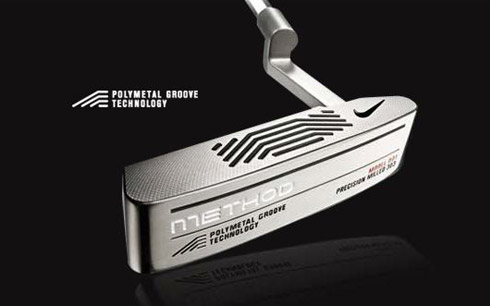
The Method prototypes have been lingering around the PGA Tour all season long, and could even be spotted in Paul Casey’s bag towards the end of the 2008 season, leaving a lot of observant people wondering how long this putter would remain a prototype, and when Nike would bring this putter to market. We don’t have to wonder any longer.
Concept and Design
The Method purports to roll the ball truer by eliminating – or at very least least minimizing – the initial bounce and backspin after impact. In order to do that, the guys at The Oven created the Polymetal Groove Technology to start the ball with forward spin instead of the normal backspin. The small grooves in the steel actually dig into the ball, similar to how a wedge or iron does (though not to that extreme, obviously) while polymer in the grooves slightly dampens the feel.
For those of us without physics and engineering degrees from MIT, Nike claims the Polymetal Groove Technology results in a more consistent and more accurate roll, while maintaining a soft feel that still provides the desired feedback. While watching a tournament on TV, you have no doubt seen a slow-motion, up-close shot of the ball bouncing immediately after impact with the putter. The Method, Nike claims, will solve the bounce issue.
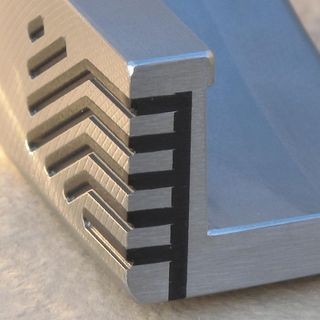 The Method’s polymer face insert is not the typical full-faced inset like you normally see in many other putters. In order to create this unique insert, the polymer is forced into a channel in the sole of the putter and is allowed to seep out of the slots that were pre-cut into the face. 30G of weight is taken from the face and body, and distributed to the back of the heel and toe, via tungsten weights in order to provide both stability and MOI (and to return the putter head to a normal weight). The combination of the milled face and the insert material provides the desired feedback, while maintaining a soft touch. Another notable design feature is that the face is about 1/8th inch shallower than most putters, leading to a lower and deeper center of gravity.
The Method’s polymer face insert is not the typical full-faced inset like you normally see in many other putters. In order to create this unique insert, the polymer is forced into a channel in the sole of the putter and is allowed to seep out of the slots that were pre-cut into the face. 30G of weight is taken from the face and body, and distributed to the back of the heel and toe, via tungsten weights in order to provide both stability and MOI (and to return the putter head to a normal weight). The combination of the milled face and the insert material provides the desired feedback, while maintaining a soft touch. Another notable design feature is that the face is about 1/8th inch shallower than most putters, leading to a lower and deeper center of gravity.
Available Models and Options
Initially, there will be five variations of the Method available: three blades and two mallets. Additionally, two blades and two more mallets will follow later. All models will be available in lengths of 33″, 34″, and 35″, will have a standard 2° of loft, and a milled face. All five feature a red grip, that is most likely produced by Winn (based on all previous Nike putters), but Nike has yet to release that information at this point. Details on the headcover are also scarce at this point, but rest assured, as more details are made available, we will make sure to keep you informed.
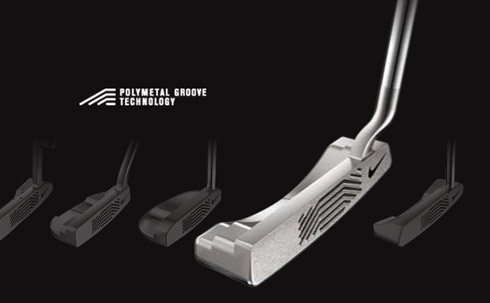
The Nike Method putter line-up. For a closer look at each of the putters, scroll down.
The Method 001 (below left) is an Anser-style blade featuring a plumber’s neck and a single alignment dot on the top of the head. The Method 002 (below right) is another blade. It features a Santa Fe-style neck and a single alignment line in the cavity.
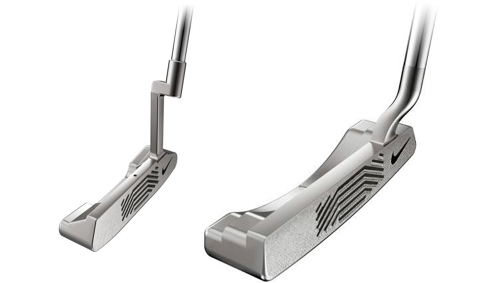
The Method 003 (below left) is a heel-shafted mallet with a single sight line and a short flare neck. The Method 004 is a heel-shafted blade. It has three sight lines, no hosel, and an S-bend shaft.
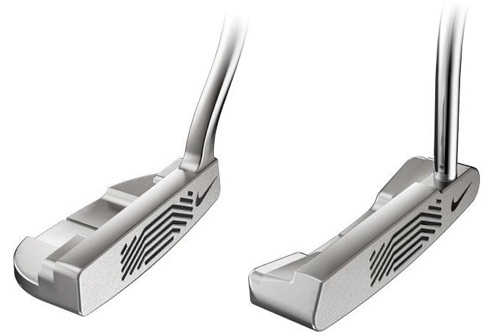
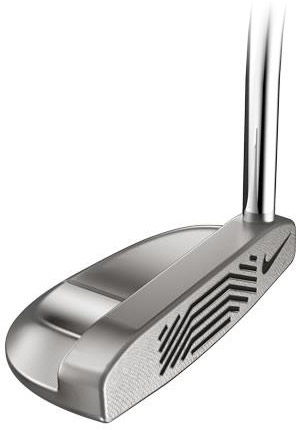 The last model (right), the Method 005 is a heel-shafted, crescent-shaped mallet with a single sight line and an S-bend shaft with no hosel.
The last model (right), the Method 005 is a heel-shafted, crescent-shaped mallet with a single sight line and an S-bend shaft with no hosel.
The Proof is in the Results
The Method has contributed to two major wins this year, as well as the rise of the current fourth best player in the world. Lucas Glover summed it up by saying “This putter has made all of the difference in my game. I attribute a lot of the success I had at Bethpage to my putting. I give a lot of credit to Nike for coming out with such a great product.” Since switching, Glover, who last year was ranked 116th in putts per round, got as high as 39th in this category and is now tied for 61st.
Surely, no one can forget Stewart Cink using the Method to sink a tough 15-foot putt to force a playoff with Tom Watson after quietly sneaking up the leaderboard at this year’s Open Championship. Cink, who had been using a belly putter on tour for the last four years, swapped in the traditional length Method earlier this year. When asked about it earlier this year, Cink said “It feels really solid and it rolls the ball really nice, I’ve been practicing hard so it feels pretty comfortable now.”
Paul Casey, ranked fourth in the world, is another big advocate of the Method. Casey was the first tour player to use it, and had to persuade Nike to get it in his bag at last year’s WGC Bridgestone Invitational. Since making the switch, Casey experienced a jump similar to G-Lover, going from 193rd in overall putting to 23rd at one point in 2009.
Tom Stites, Nike Golf’s Director of Golf Club Creation, says “It’s quite rewarding to see our athletes succeed with our products. We knew we had something good when we watched how our athletes reacted to how their ball rolled after impact.”
Pricing & Availability
For starters, the Method is Nike’s newest premium putter, so it’s not going to be the cheapest flatstick out there. Plan on this putter setting you back $249.99 when it’s released. Expect that general release to be in February of 2010, but if you’re dead set on getting it before then, there will be a special limited release starting November 1st. According to Nike Golf’s Twitter page, the limited release models will be custom made at The Oven in Fort Worth.
Final Thoughts
While Nike Golf may have a hard time carving out their space in the premium putter market, their constant innovation and dedication to making quality products should at least turn a few heads. The Method is good example of how technology and engineering directly contribute to the improvement of golfers, even at the highest level. Though Nike is not the first to implement grooves into a putter, the Method may be the most recognizable example of the difference it can make on the green, with the big wins by Cink and Glover this year.
Will the Method replace my current putter? I can’t say either way at this point, but I’m certainly interested in the difference the grooved insert makes. Though I doubt this is the missing link in my quest to hoist the Claret Jug in the near future, I’m going to at least be sure and try it out when it hits the stores early next year. If you find yourself shopping for a putter next year, give this one a look!

Putter s at $200 and above is just sheer greed!! Three years down the road and it’s on E bay!
Other than the included polymer for feel, can anyone tell me how this is different than the grooves on the Rife and Yes! putters? Isn’t this also similar to Taylormade’s AGSI insert?
They are just hopping on the groove technology train pioneered by YES! and Rife. I have a Rife Antiqua and love it… for $100 new
I am personally not crazy about the look of these.
I totaly agree it’s a personal choice.
I have had the same old stick (Zebra II by Ram) since 1978. Many of my friends and golf partners change putters 2 – 4 times a year If it works use it Remember Tiger used a Bullseye for a long time and that is like a small hockey stick
Don’t buy the hype. Play the one (all clubs included) that feels best.
Are these grooves conforming for competition in 2010. 🙂 just kidding. 🙄
I agree with other posts, this is very similar reuse of Yes and Rife products.
Since they’re filled with a polymer I think it’s a bit more like TM’s AGSI, personally. The AGSI putters we’ve reviewed on this site have been reviewed quite favorably, too. The ball rolls crisply (unlike some insert putters, which feel mushy and make distance control difficult) and seems to hug the green pretty well.
I agree, too. I’m quite happy with my Rife, which rolls very nicely and cost (new) even less than $100 on eBay, although I will be curious to see if the polymer fill helps in any noticeable way or is more of a marketing gimmick.
I have played with a George Low smooth insert for over 40 years, I switched to a TM AGSI Rosa last month and love it. Grooves are good.
… How ever, I am a little bothered by the apparently limited sweet spot on these Nikes. I suppose that if you line the ball up it doesn’t matter but I think the visual of such a limited hitting area would bug me.
I actually am really excited about thsi putter. Everyone is always ready to drop this amount on a scotty cameron putter. I have played Nike putters, as well as Callaway, Ping and even taylormade. I currently have an IC putter and a unitized putter from Nike. These two putters for me have been the ones to perform and give me my best sight lines. I switch back depending on the green make up and playing conditions. Everyone seems to think since Nike is such a yougn company and does not have ” big name” designer with them that this some how cheapens them. All companies by the way put out a product and then next year have something new so it always ends up cheaper in a year or on ebay. Again, putting as always is the most PERSONAL of all clubs. It gives the most feedback, and more than likely it will be used on every hole. To say they are stealing from Rife or Ping is just proof that some technoligies and styles work. Are most manufaturers now having the same ideas done to there style?
The photos seem to indicate the sweet spot is closer to the shaft than in the centre of face??? Is this just an optical illusion?
It’s an optical illusion. It’s in the same place as traditional Anser-like putters – pretty much what you’d think of as the middle.
I think it may be like some see mores, a really small sweetspot 😕